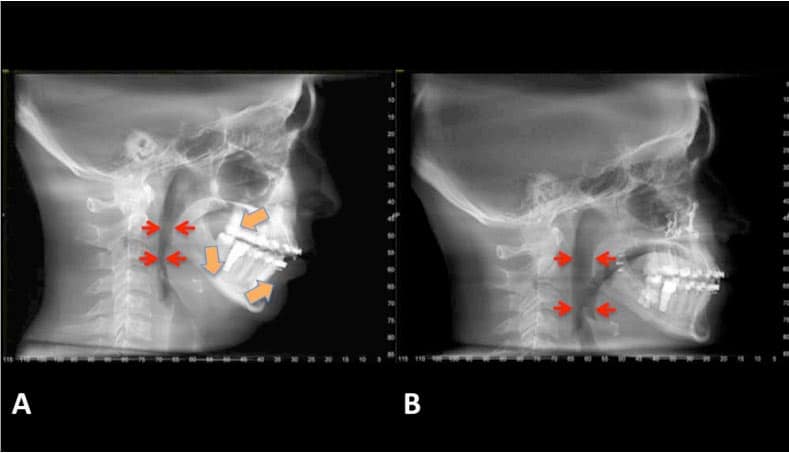Dr. Larry Wolford provides orthognathic surgery evaluation for prospective patients who may need corrective jaw surgery to cure sleep apnea.
Orthognathic (corrective jaw) surgery is a highly predictable treatment to increase the oropharyngeal airway dimensions, thus improving breathing for obstructive sleep apnea patients.
For many patients with sleep apnea, the most highly predictable treatment is to advance the maxilla and mandible in a counter-clockwise direction, which significantly opens up the oropharyngeal airway. The counter-clockwise rotation of the maxillomandibular complex usually provides the best facial aesthetic balance while maximizing the increase of the oropharyngeal airway dimensions (Figure 11).
Traditional Orthognathic Surgery Evaluation
The more traditional straightforward or clockwise advancement of the maxilla and mandible that most surgeons perform compromises the esthetic outcome and decreases the potential increase of the oropharyngeal airway.
Many of these sleep apnea patients, also have TMJ issues, which need to be addressed at the same time or before the orthognathic surgery is performed to provide a stable, predictable outcome and decrease preexisting pain.
This area will be addressed in a later section of this chapter. As the maxillary and mandibular complex is advanced forward in a counter-clockwise direction the overall facial balance is improved, the oropharyngeal airway opens and the nostrils are widened; all to improve the airway.
Our studies have shown that with the first 10 mm of advancement, the oropharyngeal airway opens up 65-70% of the amount of mandibular advancement.
With 10 to 15 mm of advancement, the oropharyngeal airway continues to open, but at a lesser percentage of the amount of mandibular advancement of only about 55-60% of the mandibular advancement. When the mandible is advanced greater than 15 mm, the oropharyngeal airway continues to open, but only about 40-45% of the amount of mandibular advancement.
Additional Facts
In treating patients with significant airway obstruction and sleep apnea issues, it is important to understand these following factors:
- Comprehensive diagnosis is necessary of the nasal, oral and oropharyngeal airways and their possible contribution to the airway compromise and sleep apnea symptoms
- TMJs are commonly involved in patients with sleep apnea issues as they may be a contributory factor in the retruded position of the mandible
- Orthodontic treatment can contribute to sleep apnea, particularly if bicuspid teeth were extracted to facilitate alignment of the teeth
- A comprehensive treatment plan should be designed to address all the functional and aesthetic issues facing the patient
- Treatment outcomes are highly predictable with accurate diagnosis and proper management of the areas contributing to the airway obstruction
- When TMJ issues are involved, the TMJ pathology must be addressed in order to provide stable treatment outcomes, decrease or eliminate TMJ and maxillofacial pain as well as TMJ related headaches.
To this day, some orthodontist continue to routinely extract bicuspid teeth, use headgear or other mechanical methods of retraction to retrude the maxilla and maxillary teeth to fit with a retruded mandible, decreasing the oral cavity volume, displacing the tongue posteriorly, and contributing to the development of sleep apnea.
Sometimes the orthodontics needs to be totally reversed so that the bicuspid spaces are reopened to improve the size of the oral cavity to better accommodate the tongue and to provide better functional and aesthetic alignment of the teeth, with the best results coupled with orthognathic surgery when indicated.
With the proper treatment of nasal, oropharyngeal and oral airway obstruction issues, patients can breathe normally, improve their health status and eliminate the need for oral sleep devices, CPAP machines, and similar kind of breathing apparatuses.


